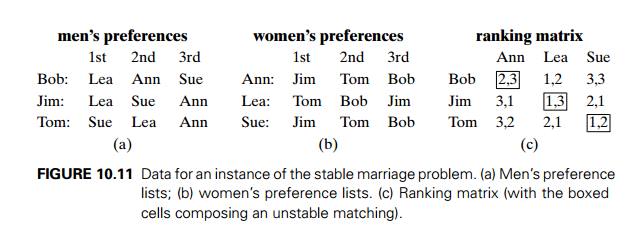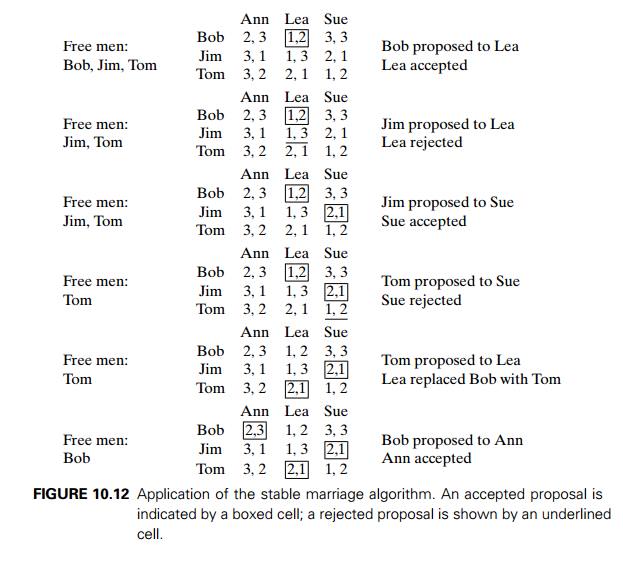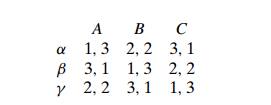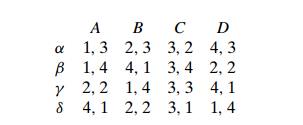Chapter: Introduction to the Design and Analysis of Algorithms : Iterative Improvement
The Stable Marriage Problem
The Stable Marriage Problem
In this section, we consider
an interesting version of bipartite matching called the stable marriage
problem. Consider a set Y = {m1, m2, . . . , mn} of n men and a set X = {w1, w2, . . . , wn } of n women. Each man has a preference list ordering the
women as potential marriage partners with no ties allowed. Similarly, each
woman has a preference list of the men, also with no ties. Examples of these
two sets of lists are given in Figures 10.11a and 10.11b. The same information
can also be presented by an n × n ranking matrix (see Figure
10.11c). The rows and columns of the matrix represent the men and women of the
two sets, respectively. A cell in row m and column w contains two rankings: the first is the position
(ranking) of w in the m’s preference list; the second is the position
(ranking) of m in the w’s preference list. For example, the pair 3, 1 in Jim’s row and Ann’s column in the matrix
in Figure 10.11c indicates that Ann is Jim’s third choice while Jim is Ann’s
first. Which of these two ways to represent such information is better depends
on the task at hand. For example, it is easier to specify a match of the sets’
elements by using the ranking matrix, whereas the preference lists might be a
more efficient data structure for implementing a matching algorithm.
A marriage matching M is a set of n (m, w) pairs whose members are selected from disjoint
n-element sets Y and X in a one-one fashion, i.e., each man m from
is paired with exactly one woman w from X and vice versa. (If we represent
and X as vertices of a complete bipartite graph with
edges connecting possible marriage partners, then a marriage matching is a
perfect matching in such a graph.)

A pair (m, w), where m ∈ Y, w ∈ X, is said to be a blocking pair for a
marriage matching M if man m and woman w are not matched in M but they prefer each other to their mates in M. For example, (Bob, Lea) is a blocking pair for
the marriage matching M = {(Bob, Ann), (Jim, Lea), (Tom, Sue)} (Figure
10.11c) because they are not matched in M while Bob prefers Lea to Ann and Lea prefers
Bob to Jim. A marriage matching M is called stable
if there is no blocking pair for it; otherwise, M is called unstable. According to this
definition, the marriage matching in Figure 10.11c is unstable because Bob and
Lea can drop their designated mates to join in a union they both prefer. The stable
marriage problem is to find a stable marriage matching for men’s and
women’s given preferences.
Surprisingly, this problem
always has a solution. (Can you find it for the instance in Figure 10.11?) It
can be found by the following algorithm.
Stable
marriage algorithm
Input: A set of n men and a set of n women along with rankings of the women by each
man and rankings of the men by each woman with no ties allowed in the rankings
Output: A stable marriage
matching
Step 0 Start with all the men and women being free.
Step 1 While there are free men, arbitrarily select one of them and do the following:
Proposal The selected free man m proposes to w, the next woman on his preference list (who is the highest-ranked woman who
has not rejected him before).
Response If w is free, she accepts the
proposal to be matched with m. If she is not free, she compares m with her current mate. If she prefers m to him, she accepts m’s proposal, making her former mate free;
otherwise, she simply rejects m’s proposal, leaving m free.
Step 2 Return the set of n matched pairs.
Before we analyze this
algorithm, it is useful to trace it on some input. Such an example is presented
in Figure 10.12.
Let us discuss properties of
the stable marriage algorithm.
THEOREM
The
stable marriage algorithm terminates after no more than n2 iterations with a stable
marriage output.
PROOF
The
algorithm starts with n men having the total of n2 women on their ranking lists. On each
iteration, one man makes a proposal to a woman. This reduces the total number
of women to whom the men can still propose in the future because no man
proposes to the same woman more than once. Hence, the algorithm must stop after
no more than n2 iterations.

Let us now prove that the
final matching M is a stable marriage
matching. Since the algorithm stops after all the n men are one-one matched to the n women, the only thing that needs to be proved
is the stability of M. Suppose, on the contrary,
that M is unstable. Then there
exists a blocking pair of a man m and a woman w who are unmatched in M and such that both m and w prefer each other to the persons they are
matched with in M. Since m proposes to every woman on his ranking list in
decreasing order of preference and w precedes m’s match in M, m must have proposed to w on some iteration. Whether w refused m’s proposal or accepted it but replaced him on a subsequent
iteration with a higher-ranked match, w’s mate in M must be higher on w’s preference list than m because the rankings of the men matched to a given woman may only
improve on each iteration of the algorithm. This contradicts the assumption
that w prefers m to her final match in M.
The stable marriage algorithm
has a notable shortcoming. It is not “gender neutral.” In the form presented
above, it favors men’s preferences over women’s preferences. We can easily see
this by tracing the algorithm on the following instance of the problem:

The algorithm obviously
yields the stable matching M = {(man 1, woman 1), (man 2,
woman 2)}. In this matching, both men are matched to their first choices, which
is not the case for the women. One can prove that the algorithm always yields a
stable matching that is man-optimal: it assigns to each man
the highest-ranked woman possible under any stable marriage. Of course, this
gender bias can be reversed, but not eliminated, by reversing the roles played
by men and women in the algorithm, i.e., by making women propose and men accept
or reject their proposals.
There is another important
corollary to the fact that the stable marriage algorithm always yields a
gender-optimal stable matching. It is easy to prove that a man (woman)-optimal
matching is unique for a given set of participant preferences. Therefore the
algorithm’s output does not depend on the order in which the free men (women)
make their proposals. Consequently, we can use any data structure we might
prefer—e.g., a queue or a stack—for representing this set with no impact on the
algorithm’s outcome.
The notion of the stable
matching as well as the algorithm discussed above was introduced by D. Gale and
L. S. Shapley in the paper titled “College Admissions and the Stability of
Marriage” [Gal62]. I do not know which of the two applications mentioned in the
title you would consider more important. The point is that stability is a
matching property that can be desirable in a variety of applications. For
example, it has been used for many years in the United States for matching
medical-school graduates with hospitals for residency training. For a brief
history of this application and an in-depth discussion of the stable marriage
problem and its extensions, see the monograph by Gusfield and Irwing [Gus89].
Exercises 10.4
Consider an instance of the
stable marriage problem given by the following ranking matrix:

For each of its marriage
matchings, indicate whether it is stable or not. For the unstable matchings,
specify a blocking pair. For the stable matchings, indicate whether they are
man-optimal, woman-optimal, or neither. (Assume that the Greek and Roman
letters denote the men and women, respectively.)
Design a simple algorithm for checking whether a given marriage
matching is stable and determine its time efficiency class.
Find a stable marriage matching for the instance given in Problem 1
by apply-ing the stable marriage algorithm
in its men-proposing version.
in its women-proposing version.
Find a stable marriage
matching for the instance defined by the following ranking matrix:

Determine the time-efficiency class of the stable marriage
algorithm
in the worst case.
in the best case.
Prove that a man-optimal stable marriage set is always unique. Is
it also true for a woman-optimal stable marriage matching?
Prove that in the man-optimal stable matching, each woman has the
worst partner that she can have in any stable marriage matching.
Implement the stable-marriage algorithm given in Section 10.4 so
that its running time is in O(n2). Run an experiment to ascertain its
average-case efficiency.
Write a report on the college admission problem
(residents-hospitals assign-ment) that generalizes the stable marriage problem
in that a college can accept “proposals” from more than one applicant.
Consider the problem of the roommates, which is
related to but more difficult than the stable marriage problem: “An even number
of boys wish to divide up into pairs of roommates. A set of pairings is called
stable if under it there are no two boys who are not roommates and who prefer
each other to their actual roommates.” [Gal62] Give an instance of this problem
that does not have a stable pairing.
SUMMARY
The iterative-improvement technique involves finding a solution to an
op-timization problem by generating a sequence of feasible solutions with
improving values of the problem’s objective function. Each subsequent so-lution
in such a sequence typically involves a small, localized change in the previous
feasible solution. When no such change improves the value of the objective
function, the algorithm returns the last feasible solution as optimal and
stops.
Important problems that can
be solved exactly by iterative-improvement algorithms include linear
programming, maximizing the flow in a network, and matching the maximum
possible number of vertices in a graph.
The simplex method is the classic method for solving the general linear
programming problem. It works by generating a sequence of adjacent extreme
points of the problem’s feasible region with improving values of the objective
function.
The maximum-flow problem asks to find the maximum flow possible in a
network, a weighted directed graph with a source and a sink.
The Ford-Fulkerson method is a classic template for solving the
maximum-flow problem by the iterative-improvement approach. The shortest-augmenting-path method implements
this idea by labeling network vertices in
the breadth-first search manner.
The Ford-Fulkerson method
also finds a minimum cut in a given
network.
A maximum cardinality matching is the largest subset of edges in a
graph such that no two edges share the same vertex. For a bipartite graph, it
can be found by a sequence of augmentations of previously obtained matchings.
Related Topics